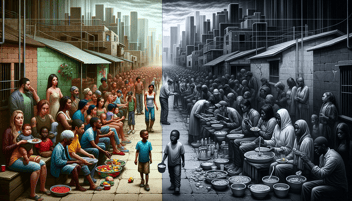
The percentage of U.S. adults who identify as lesbian, gay, bisexual, transgender, queer or something other than heterosexual has increased to a new high of 7.1% -- double the percentage from 2012, when Gallup first measured it.1 Healthcare for this population needs attention.
In 2023, healthcare research firm KFF reported that LGBT+ people are more likely to be in fair or poor health than non-LGBT+ people despite being a younger population overall.2
In the U.S. the National LGBT Health Education Center reports that LGBT youth are at higher risk for becoming infected with HIV and other sexually transmitted diseases.3 In addition, LGBT people overall are much more likely to smoke than others; have higher rates of alcohol use, other drug use, depression and anxiety; are less likely to get preventive services for cancer; and have higher rates of behavioral health issues. Elderly LGBT individuals face barriers to healthcare because of isolation, diminished family supports and reduced availability of social services.
More than one in six of LGBT people avoid healthcare due to anticipated discrimination.4 LGBT+ people are more likely to report a range of negative provider experiences compared to non-LGBT+ people, according to KFF.5 For example, they may encounter healthcare professionals who refuse to believe they are telling the truth, who assume they are personally to blame for a health problem, or who dismiss their concerns.
A Global Issue
Deficiencies in LGTBQ+ healthcare span the globe.
In England, the 2017 National LGBT survey, with over 108,000 responses, reported that at least 16% of respondents who accessed or tried to access public health services had a negative experience because of their sexual orientation, and at least 38% had a negative experience because of their gender identity.6
In an online survey of 15,611 Chinese LGB people, the results of which were published in 2020, more than three quarters said they would be willing to disclose to their medical care providers their sexual orientation if asked.7 However, only 5.7% said that medical care providers ever asked them about their it. Eight percent had experienced negative treatment in medical care settings, and almost 6% of those accessing mental health care services were recommended, coaxed into, or provided conversion therapy for sexual orientation, gender identity or gender expression.
In Brazil, the “National Policy for comprehensive health of lesbians, gays, bisexuals and transgender populations” was created in 2011.8 But implementation lags due to underbudgeting, lack of training of healthcare personnel, and challenges in monitoring and assessing proposed health interventions. Meanwhile, Venezuela lacks health policies directed at this population altogether.
In an online survey of 15,611 Chinese LGB people, the results of which were published in 2020, more than three quarters said they would be willing to disclose to their medical care providers their sexual orientation if asked
In India, despite a 2018 Supreme Court decision emphasizing that the “right to health is indispensable” for the LGBT+ community, researchers report that members of the community might face denial of care, suboptimal care or abuse, which may be verbal, physical, or sexual.9 This is especially true for members who are “visibly queer” or disclose their identities to their healthcare provider. The discrimination may also be covert, in that the provider may ignore or fail to acknowledge the LGTB+ patient’s identity or avoid discussions of same-sex practices or issues related to gender transition.
A lack of formal training on LGBTQ+ health is exacerbating the problem. In a study of 176 U.S. and Canadian medical schools, a median of only five hours was spent on LGBTQ-specific content, and one-third of schools reported no time spent at all.10
Progress
Despite the dismal statistics, efforts are being made around the world to improve LGBTQ+ healthcare.
The adoption by the World Health Organization of the 2030 Agenda for Sustainable Development and its pledge to “leave no one behind” has reinforced the need to understand and improve the health and well-being of LGBTIQ+ people.11 WHO develops guidelines, provides technical support and conducts research to help countries develop and strengthen inclusive health systems and policies.
In 2018 the British government launched the National LGBT Action Plan, the vision being that everyone - regardless of sexual orientation, gender identity or sex characteristics – can live safe, happy and healthy lives without fear of discrimination.12 The plan includes developing and sharing best practice education to improve healthcare professionals’ awareness and understanding of LGBT communities.
A Welcoming Environment
In the doctor’s office, providers and their staff can improve their daily interactions with patients from the LGBTQ+ community. In the United States, GLMA: Health Professionals Advancing LGBTQ+ Equality, in collaboration with the Tegan and Sara Foundation, launched the LGBTQ+ Healthcare Directory, connecting over 2,700 providers to patients across all 50 states.13 The Directory offers a list of “Top 10 Ways to Create a Welcoming Environment for LGBTQ+ Patients,” which includes14:
- Have—and post—an inclusive nondiscrimination policy.
- Update website and social media. In providers’ profiles, include relevant expertise in LGBTQ+ health, transgender health, and HIV/AIDS.
- Add LGBTQ-friendly literature and signage to waiting rooms.
- Update forms for sexual orientation and gender identity data collection. Ask patients or clients about their “current gender identity” separately from their “sex assigned at birth,” ask sexual orientation, pronouns, and current name; and keep legal/insurance information separate when different.
- Provide all-gender single-user restrooms.
- Train staff to ask and use pronouns and name correctly and consistently.
- Take an inclusive sexual history by asking the “5 P’s” recommended by the Centers for Disease Control and Prevention: Partners, Practices, Protection, Past History, Pregnancy.
- Troubleshoot insurance coverage and concerns for patients. Some examples include transgender patients who may have a gender identity that is different than their sex assigned at birth, and baby-making for LGBTQ+ families.
- Appreciate the impact of homophobia and transphobia. Stress and discrimination mean many LGBTQ+ people lack early detection and educational outreach, which leads to higher rates of many preventable and treatable conditions.
- Come out. If you feel safe to do so, let patients know you are part of the LGBTQ+ community or an ally.
“The evidence that LGBT+ people have disproportionately worse health outcomes and experiences of healthcare is both compelling and consistent,” says Dr. Michael Brady, national LGTB health advisor for England’s NHS. “This is unacceptable, and we need to increase our efforts to address these health inequalities.”15
Note. Variations on the LGBTQ+ acronym were used throughout this article in order to comply with different organization’s or government’s nomenclature or to reflect the way they appeared in references or articles used in the writing of this blog.
References
- LGBT Identification in U.S. Ticks Up to 7.1%, Gallup
- LGBT+ People’s Health Status and Access to Care, KFF
- Providing Inclusive Services and Care for LGBT People, National LGBT Health Education Center
- Discrimination in the United States: Experiences of lesbian, gay, bisexual, transgender and queer Americans, Health Services Research
- LGBT+ People’s Health Status and Access to Care, KFF
- LGBT health, NHS England
- A nationwide cross-sectional study of 15,611 lesbian, gay and bisexual people in China: disclosure of sexual orientation and experiences of negative treatment in health care, International Journal for Equity in Health
- Health and equity: Venezuela’s and Brazil’s public health policies aimed at the LGBTQ+ population, European Journal of Public Health
- Healthcare, culture & curriculum: addressing the need for LGBT+ inclusive medical education in India, The Lancet Regional Health Southeast Asia
- Rainbows and “Ready for Residency”: Integrating LGBTQ Health Into Medical Education, MedEdPORTAL
- Improving LGBTIQ+ health and well-being with consideration for SOGIESC, World Health Organization
- LGBT+ action plan priorities, NHS England
- GLMA and Amino Health Collaborate to Enhance and Expand LGBTQ+ Affirming Care Access through the LGBTQ+ Healthcare Directory, GLMA: Health Professionals Advancing LGBTQ+ Equality
- Top 10 Ways to Create a Welcoming Environment for LGBTQ+ Patients, LGBTQ+ Healthcare Directory
- LGBT health, NHS England



Share Article